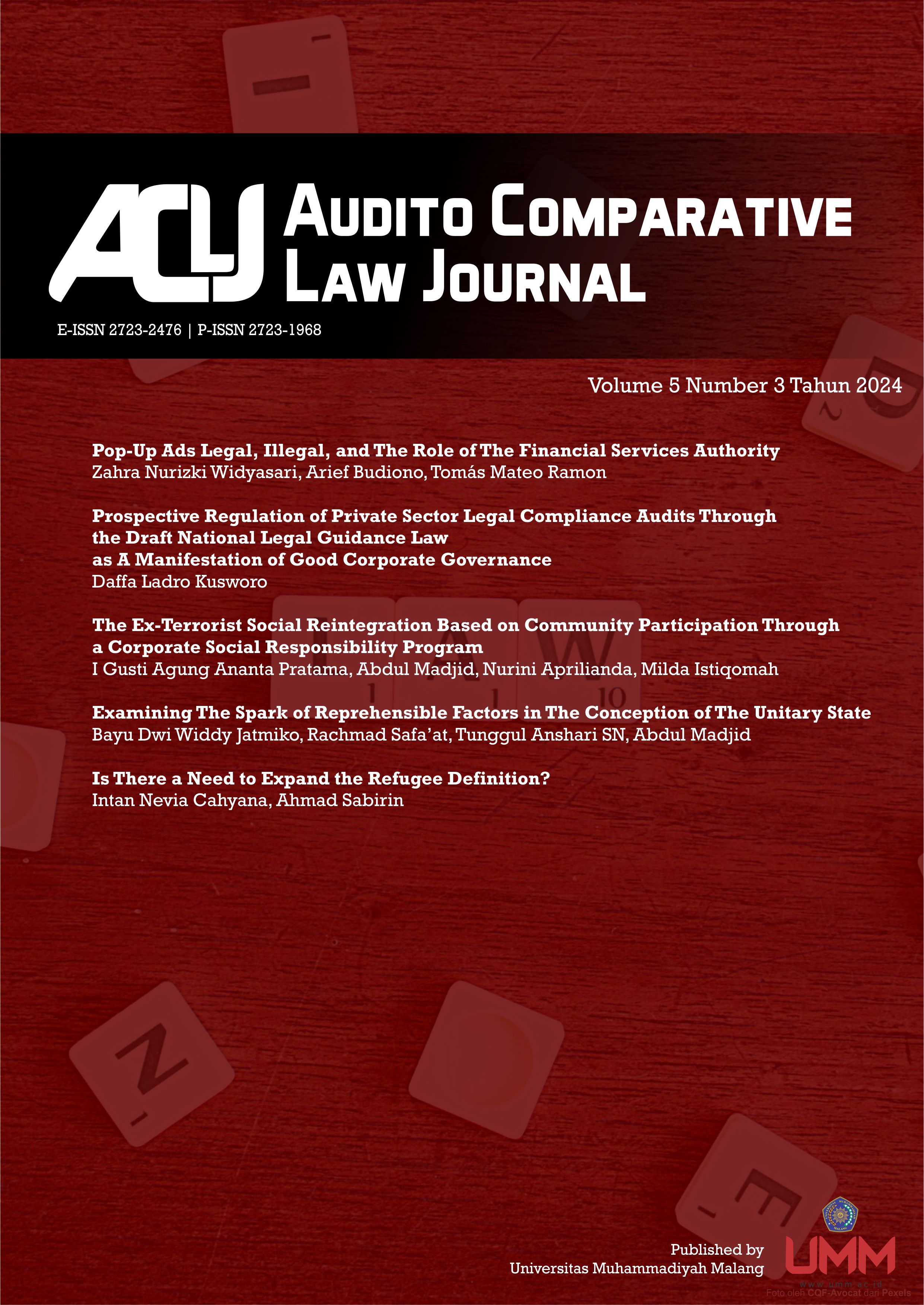Pop-Up Ads Legal, Illegal, and The Role of The Financial Services Authority
DOI:
https://doi.org/10.22219/aclj.v5i3.33471Keywords:
Pop-up, Ads, Online loans, OJKAbstract
Pop-up ads are notifications on the smartphone window when opening a website or application, which are useful for attracting users when crossing the web. Legal and illegal online loans also utilize this feature in marketing their services. The Financial Services Authority has a vital role in eradicating these pop-up ads so as not to cause unrest in the community. The aim is to find out how the role of the Financial Services Authority in controlling the circulation of online loan pop-up ads and what the consequences are. This literature study research uses normative juridical research methods. The data combines primary, secondary, and tertiary legal sources, then processed through descriptive analysis to obtain detailed and structured results. The results show that pop-up ads for online loans, especially illegal ones, can bring unrest to the community. Therefore, people can be easily tempted to take out loans and end up badly when they cannot repay them. The reasons behind a person making a loan vary, such as attractive advertisements or urgent economic circumstances. The Financial Services Authority and other government agencies are working together to eradicate illegal online loans, one of which is blocking them so that only verified online loan pop-up ads remain. The hope is that the public does not need to worry about accessing online loans through pop-up ads because it can be ascertained that these loans are legal. This research concludes that online loan pop-up ads are still so troubling that the role of the Financial Services Authority and other government agencies needs to be improved. The Financial Services Authority must not be careless in eradicating them to create a healthy and safe economic environment for the community.
Downloads
References
Agusta, H. (2020). Perlindungan Data Pribadi Penerima Pinjaman Dalam Transaksi Pinjam Meminjam Uang Berbasis Teknologi Informasi (Peer to Peer Lending). Krtha Bhayangkara, 14(2), 156–183. https://doi.org/https://doi.org/10.31599/krtha.v14i2.189
Al-Fatih, S. (2023). Perkembangan Metode Penelitian Hukum di Indonesia (1st ed.). Malang: UMM Press.
Ansari, T., & Negara, S. (2023). Normative Legal Research in Indonesia: Its Originis and Approaches. Audito Comparative Law Journal (ACLJ), 4(1), 1–9. https://doi.org/10.22219/ACLJ.V4I1.24855
Aripin, Z. (2021). Marketing Management. Deepublish.
BBC News Indonesia. (2021). Pinjol Ilegal Bermunculan Akibat Lemahnya Sistem Hingga Perilaku Masyarakat Konsumtif Sehingga Terjerat ‘Lintah Digital’’.’
Budiyanti, E. (2019). Upaya Mengatasi Layanan Pinjaman Online Ilegal. Jurnal Pusat Penelitian Badan Keahlian DPR RI, 11(4), 19.
Chrismastianto, I. A. W. (2017). Analisis Swot Implementasi Teknologi Finansial terhadap Kualitas Layanan Perbankan di Indonesia. Jurnal Ekonomi Dan Bisnis, 20(1), 133–144. https://doi.org/https://doi.org/10.24914/jeb.v20i1.641
Darman, D. (2019). Financial Technology (FinTech): Karakteristik dan Kualitas Pinjaman pada Peer to Peer Lending di Indonesia. Jurnal Manajemen Teknologi, 18(2), 130–137. https://doi.org/https://doi.org/10.12695/jmt.2019.18.2.4
FinTech Weekly. (n.d.). FinTech Definition.
Gaji Gesa. (2022). Seram! Ini 7 Pengalaman Pengguna yang Tidak Membayar Utang Pinjaman Online.
Hariyanto, D. (2023). Buku Ajar Komunikasi Pemasaran. Umsida Press, 1–142. https://doi.org/https://doi.org/10.21070/2023/978-623-464-068-7
Hasil Wawancara dengan Andrei Romario Selaku Staf di Bagian Deputi Direktur Kebijakan Penyidikan OJK. (2020).
Ichwan, I., & Kasri, R. A. (2019). Why Are Youth Intent On Investing Through Peer To Peer Lending? Evidence From Indonesia. Journal of Islamic Monetary Economics and Finance, 5(4), 741–762. https://doi.org/https://doi.org/10.21098/jimf.v5i4.1157
Ika, A. (2018). 5 Layanan Tekfin yang Patut Diperhatikan di 2018.
Kao, C.-T., & Wang, M.-Y. (2013). The right level of complexity in a Banner Ad: Roles of construal level and fluency. Human Interface and the Management of Information. Information and Interaction Design: 15th International Conference, HCI International 2013, Las Vegas, NV, USA, July 21-26, 2013, Proceedings, Part I 15, 604–613. https://doi.org/https://doi.org/10.1007/978-3-642-39209-2_67
Kompasmania. (2023). Bahaya Pinjaman Online (Pinjol) dan Dampaknya bagi Masyarakat.
Latumahina, R. E. (2014). Aspek Hukum Perlindungan Data Pribadi di Dunia Maya.
Masriansyah, L. (2020). Go Digitial And Customer Relationship Marketing Sebagai Strategi Pemulihan Bisnis Umkm Yang Efektif Dan Efisien Di Masa Adaptasi New Normal. Equator Journal of Management and Entrepreneurship, 8(4), 126–140.
Noviandari, A. (2020). Perlindungan Hukum Terhadap Nasabah Dalam Pinjaman Online Dengan Fidusia. Universitas Islam Kalimantan MAB.
Nurhayati, I. I., & Utaminingsih, S. (2021). Analisis Dampak dan Resiko Hukum Terhadap Praktik Pinjaman Online di Masa Pandemi. Rechtsregel Jurnal Ilmu Hukum, 04(01).
Omblogging. (n.d.). Pengaruh Iklan Pop Up Bagi Pengunjung dan SEO.
Otoritas Jasa Keuangan. (n.d.). FAQ Fintech Lending.
Otoritas Jasa Keuangan. (2021a). Waspada! Pinjaman Online Ilegal.
Otoritas Jasa Keuangan. (2021b). Waspada Investasi Perkuat Penegakan Hukum Berantas Pinjaman Online Ilegal.
Otoritas Jasa Keuangan. (2022). Waspada Investasi Kembali Temukan 10 Entitas Investasi Ilegal Dan 100 Pinjaman Online Ilegal.
Otoritas Jasa Keuangan. (2023). Satgas Pasti blokir 302 Pinjol Ilegal dan Pinpri [Siaran Pers].
Pardosi, R., & Primawardani, Y. (2020). Perlindungan Hak Pengguna Layanan Pinjaman Online Dalam Perspektif Hak Asasi Manusia (Protection of the Rights of Online Loan Customers from a Human Rights Perspective). Jurnal Ham, 11(3), 353–367. https://doi.org/https://doi.org/10.30641/ham.2020.11.353-368
Peraturan Menteri Komunikasi dan Informatika Nomor 3 Tahun 2018.
Pranita, N. K. P., & Suardana, W. (2019). Perlindungan Hukum Terhadap Nasabah Pengguna Layanan Fintech (Financial Technology). Kertha Semaya Jurnal Ilmu Hukum, 07(02), 1–16.
Pratama, D. R. (2021). ANALISIS DAYA TARIK IKLAN POP-UP YOUTUBE DI KALANGAN MAHASISWA. Jurnal Kaganga: Jurnal Ilmiah Sosial Dan Humaniora, 5(1), 39–48. https://doi.org/https://doi.org/10.33369/jkaganga.5.1.39-48
Pratama, W. P. (2021). Basmi Pinjol Ilegal, Google Syaratkan Lisensi OJK untuk Aplikasi Pinjaman Pribadi.
Priliasari, E. (2019). Pentingnya Perlindungan Data Pribadi Dalam Transaksi Pinjaman Online. Majalah Hukum Nasional, 49(2), 1–27. https://doi.org/https://doi.org/10.33331/mhn.v49i2.44
Purwanto, H., Yandri, D., & Yoga, M. P. (2022). Perkembangan dan Dampak Financial Technology (Fintech) Terhadap Perilaku Manajemen Keuangan di Masyarakat. Kompleksitas: Jurnal Ilmiah Manajemen, Organisasi Dan Bisnis, 11(1), 80–91. https://doi.org/https://doi.org/10.56486/kompleksitas.vol11no1.220
Rachbini, W., & Hatta, I. H. (2018). E-lifestyle and internet advertising avoidance. Jurnal Manajemen, 22(3), 435–448. https://doi.org/https://doi.org/10.24912/jm.v22i3.432
Rahmatullah, I. (2021). Pentingnya Perlindungan Data Pribadi Dalam Masa Pandemi Covid-19 Di Indonesia. ADALAH, 5(1), 11–20. https://doi.org/https://doi.org/10.15408/adalah.v5i1.19811
Sekarwangi, M., & Triharyanto, A. (2023). Iklan Sebagai Faktor Pengganggu Kenyamanan Pengguna Media Daring. Yos Soedarso Economic Journal (YEJ), 5(1), 1–19.
Susanto, H. (2008). Hak-hak Konsumen Jika Dirugikan. Jakarta: Visimedia.
Syafi’i, M., & Bashori, D. C. (2020). Sosialisasi Produk Pinjaman Dan Investasi Online Ilegal Berdasarkan Penilaian Otoritas Jasa Keuangan (OJK) Pada Anggota Dasa Wisma Perumahan Alam Hijau Jember. Jurnal Pengabdian Masyarakat Iptek, 6(1), 48–52.
Wati, D., & Syahfitri, T. (2021). Dampak Pinjaman Online Bagi Masyarakat. Community Development Journal: Jurnal Pengabdian Masyarakat, 2(3), 1181–1186. https://doi.org/https://doi.org/10.31004/cdj.v2i3.2950
Widiatmoko, D., & Tohir, M. (2020). Perangkap Visual Pop Up di Smartphone. Jurnal Desain Komunikasu Visual& Multimedia, 06(02), 142.
Downloads
Published
How to Cite
Issue
Section
License
Copyright (c) 2024 Zahra Nurizki Widyasari, Arief Budiono, Tomás Mateo Ramon

This work is licensed under a Creative Commons Attribution-ShareAlike 4.0 International License.








